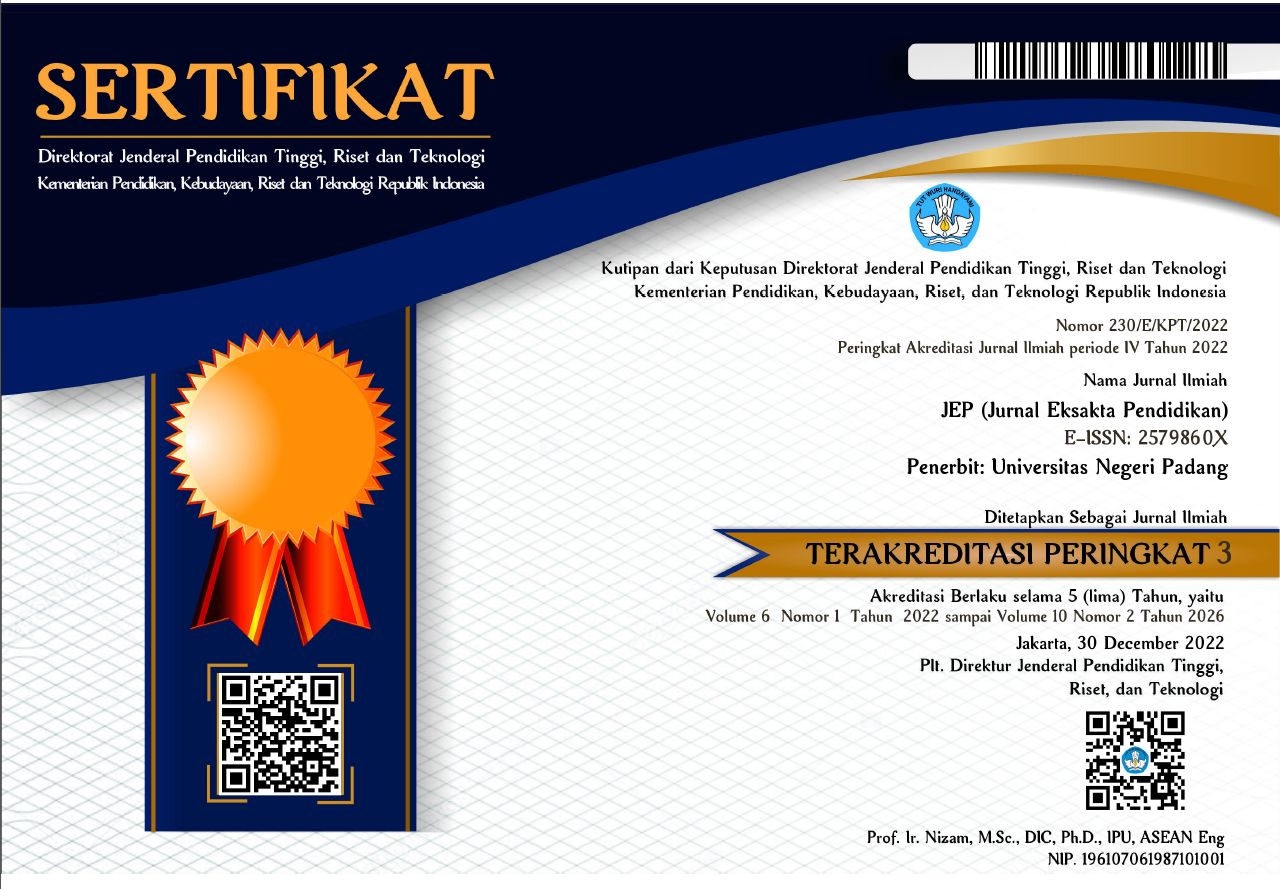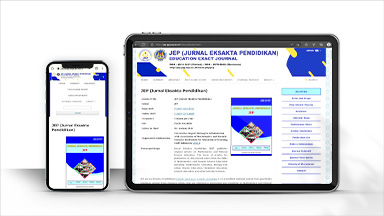Menumbuhkan Kemampuan Berpikir Kreatif Peserta Didik SMP Melalui Perangkat Pembelajaran Berbasis Teori M-APOS
Abstract
The ability to think creatively is an ability that is expected to be mastered by students but is still low. Students lack the ability to solve a problem in a various ways.The purpose of this study is to produce a learning tool based on M-APOS theory to improve students' creative thinking abilities.The research method used in this research is research and development which consists of three stages, namely the initial investigation stage, the development stage and the assessment stage.In this section what is done is the preliminary research stage. The instruments used were interview and questionnaire guidelines.The results of the study are: 1) inadequate school facilities and infrastructure, 2) student learning outcomes are still low because students are accustomed to accept what is taught and do not repeat the lessons at home, 3) worksheets that are used by students is not attractive, 4) in the learning process students prefer group learning, 5) students want the questions contained in LKPD to be daily life problems, 6) the learning environment of students who are in the hills and close to the highway, 7) learning styles favored by students are in the form of solving problems in the form of images related to daily life problems, 8) the appearance of worksheets that are liked by students is LKPD which has pictures and attractive color.
Downloads
References
Armiati, A. Anggraini, N. Devi, S. 2018. Dampak Pembelajaran Berbasis Masalah terhadap Kemampuan Pemecahan Masalah, Koneksi Matematis dan Kecerdasan Emosional Siswa SMP. Jurnal Eksakta Pendidikan, Vol. 2 no. 1 tahun 2018
Arnawa, M. 2009. Pengembangan Perangkat Pembelajaran Berdasarkan Teori APOS. Artikel IlmiahPenelitian Hibah Bersaing, (online). http://repository.unand.ac.id/29/ 1/Artikel HB-09_%28I_Made_Arnawa% 29.rtf, diakses 24 Agustus 2017).
Dubinsky, E. 2010. “The APOS theory of learning mathematics: Pedagogical applications and results”. Paper presented at the Eighteenth Annual Meeting of the Southern African Association for Researchin Mathematics,Science and Technology Education. Durban, SouthAfrica.
Elda Herlina. 2013. Meningkatkan Disposisi Berpikir Kreatif Melalui Pendekatan APOS. Infinity journal. Vol 2 no 2. STKIP Siliwangi. www. E.journal. stkipsiliwangi.ac.id /index.php/infinity/ article/ view/33.
Kadir. 2017. The Implementation Of Open-Inquiry Approach To Improve Students’ Learning Activities, Responses, and mathematical creative thinking skils. Journal on mathematics education. Vol 8 no 1. Universitas Islam Negeri Syarif Hidayatullah.
Khairani. Amry, Z. Harahap, R. 2018. Upaya Meningkatkan Kemampuan Berpikir Kritis Siswa Kelas X Melalui Pembelajaran Kooperatif Tipe Numbered Head Together. Jurnal Eksakta Pendidikan, Vol. 2 no. 1 tahun 2018
Lestari, Sri Wiji. 2014. ”Penerapan Model Pembelajaran M-APOS Dalam Mening katkan Pemahaman Konsep Dan Motivasi Belajar Kalkulus II”. Jurnal Pendidikan dan Keguruan Vol. 1 No. 1, artikel 6
Marsitin, Retno. 2017. “Koneksi matenatis dan berfikir kreatif dalam pembelajaran matematika dengan teori APOS”. Al-Khwarizmi: Jurnal Pendidikan Matema tika dan Ilmu Pengetahuan Alam, Maret 2017, Vol.5, No.1, hal.87- 100 ISSN(P): 2527-3744; ISSN(E):2541-6499.
Mandasari, selvia et. al. 2018. “Development of Mathematics Lesson Equipment Based On M-APOS Model To Improve Creative Thinking Skill On Grade X Student At The Senior High School” Advances In Sosial Science, Education and Humanities Research (ASSEHR). Vol. 285. 2nd International Conference On Mathematics and Mathematics Education (ICM2E 2018).
Murdikah, Achmad. 2016. Problem Based Learning Associated By Action, Proses, Object and Schema (APOS) Theory To Enhance Students’ High Order Mathematical Thinking Ability. Interna tional journal of research in education and science (IJRES). 2(1), 125-135.
Mursina, Elly’s M, dkk. 2015.”Kemampuan Berpikir Kreatif DalamMemecahkan Masalah Matematika Open-EndedDitinjau Dari Tingkat Kemampuan Matematika Pada Siswa Sekolah Dasar” Journal Pedagogia ISSN 2089-3833. Vol 4. No 1.
Plomp, T and Nieveen, N. 2013. An Introduction toEducational Design Research. Enschede: Netherland Institute for Curriculum Development (SLO).
Rhamayanti, Y dan Nurdalilah. (2018) Peningkatan Kemampuan Penalaran Matematika dan Sikap Siswa melalui Penerapan Pembelajaran Matematika dengan Pendekatan Open Ended pada Siswa Kelas VIII-2 SMPN 7 Padang Sidimpuan. Jurnal Eksakta Pendidikan, Vol. 2 no. 2 2018
Rohimah. S. et.al., (2017).”implementasi advance organizer dan M-APOS dalam meningkatkan pemahaman matematis” Jurnal Analisa 3 (1) (2017): 93-105 p-ISSN: 2549-5135. http://journal.uinsgd. ac.id/index.php/ analisa/index e-ISSN : 2549-5143.
TIMSS. 2011. International Result In Mathematics.Chestnust Hill: TIMSS dan PIRLS International Study Center, (online) http://timssdprils.bc.edu/timss 2011/international-result-math).
Voskoglou, M. 2013. “An Application Of The APOS/ACE Approach In The Teaching The Irrational Number. Journal Of Mathematical Science & Mathematics Education. Vol. 8. No 1
Widiastuti & Putri. 2018. “Kemampuan Berpikir Kreatif Siswa Pada Pembelajaran Operasi Pecahan Menggunakan Pendekatan Open-Ended”. Jurnal pendidikan matematika.
Vol. 12. No. 2 ISSN 1978-0044 E-ISSN 2549-1040.
Yerizon. et. al. 2019. “DevelopmentOf Student’s Worksheet Based On APOS Theory Approach To Improve Student Achievement In Learning System Of Linear Equations. International Journal Of Scientific & Technology Research. Vol 8. ISSN 2277-8616
Copyright (c) 2019 Yerizon Yerizon, Ihksan Apria Suske, Armiati Armiati

This work is licensed under a Creative Commons Attribution 4.0 International License.

This work is licensed under a Creative Commons Attribution 4.0 International License.




_(2579-860X).png)
_(2614-1221)1.png)




